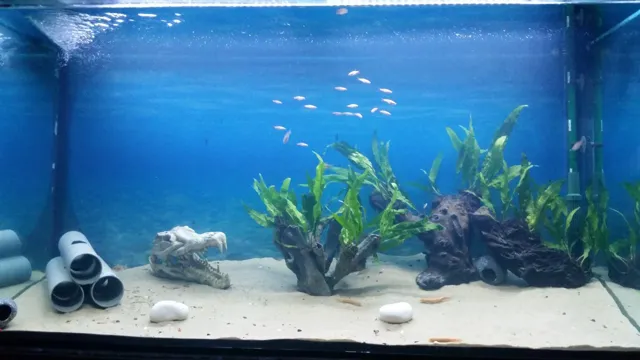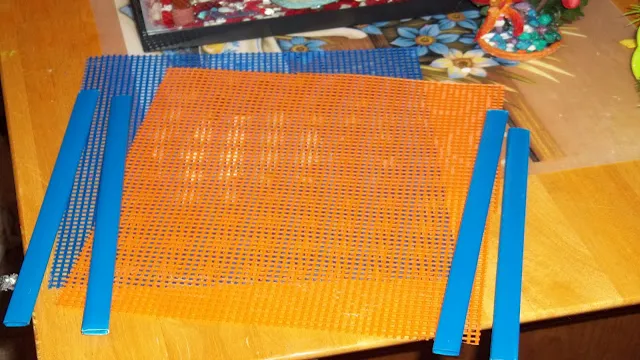Aquariums are a beautiful way to add life and color to any room in your home. Watching fish swim and glide through the water can be a calming and therapeutic experience. However, one concern that comes with owning an aquarium is the potential damage it can cause to your flooring.
Water spills, scratches, and weight are just a few things that can ruin your floor if you’re not careful. In this blog post, we will explore different ways to protect your floor from your aquarium, allowing you to enjoy your aquatic friends without worrying about the damage they might cause. So, are you ready to learn how to keep your floor safe and your fish happy? Let’s dive in!
Choose the Right Location
When it comes to maintaining an aquarium at home, one of the biggest concerns is preventing any damage to the floor. Choosing the right location for your aquarium is crucial in ensuring that the floor doesn’t get ruined. The first thing to consider is the weight of the tank, as it can be quite heavy once it’s filled with water.
Therefore, it’s essential to choose a location that can handle the weight of the tank and the water. Additionally, it’s best to place the tank on a flat and level surface, such as a sturdy stand. It’s also important to consider the type of flooring you have.
Hardwood, laminate, and tile flooring can all be susceptible to water damage, so it’s crucial to place a protective barrier, such as a plastic or rubber mat, under the tank to prevent any leaks or spills from causing any significant damage. By choosing the right location for your aquarium and taking the necessary precautions, you can keep your aquarium from ruining your floor and enjoy a beautiful and healthy aquatic environment in your home.
Consider the Weight of Your Aquarium
When considering the weight of your aquarium, one important factor to keep in mind is choosing the right location. You want to make sure that the surface you place your aquarium on is strong enough to support its weight. A good rule of thumb is to choose a location near a load-bearing wall, as this can provide additional support.
It’s also recommended to place your aquarium on a level surface, as an uneven foundation can cause stress to the tank and potentially lead to cracks or leaks. Additionally, you’ll want to ensure that the area around the aquarium is clear of any potential hazards, such as high traffic areas or objects that could fall and damage the tank. By taking these precautions and choosing a suitable location, you’ll help ensure the longevity and safety of your aquarium.

Avoid Placing the Tank on Wood or Carpet
If you’re planning to set up an aquarium, one of the most important considerations is where to place it. One common mistake is to put the tank on top of wood or carpet, which can cause damage and potential hazards. Instead, choose a sturdy, flat surface that can support the weight of the tank and its contents.
Ideally, the location should also be level and away from direct sunlight or heat sources that can cause fluctuations in temperature. Don’t forget to take into account the needs of your aquatic creatures – some fish require more light or a particular temperature range. By taking the time to choose the right location, you’ll create a safer and healthier environment for your aquarium.
Remember, a little planning now can save you headaches later on!
Create a Barrier Between the Tank and Floor
If you’re worried about your aquarium ruining your floors, the best solution is to create a barrier between the tank and the floor. This can be as simple as using a rubber mat or a piece of plywood as a base for the tank. If you want to take things a step further, you can consider adding an aquarium stand or cabinet. (See Also: How to Kill Hydra in Aquarium: A Comprehensive Guide for Aquarists)
These will not only provide a sturdy base for your tank, but they will also protect your floors from any potential leaks or spills. Another option is to use a drip tray underneath the aquarium to catch any excess water or spills. Whatever approach you take, it’s important to prioritize the safety of your floors and to take steps to prevent any damage from occurring.
Use a Waterproof Mat or Tray
When it comes to setting up an aquarium, one thing to keep in mind is the importance of using a waterproof mat or tray. Not only does this help protect your floor from any potential spills or leaks, but it also creates a barrier between the tank and floor. This is especially important if you have a larger aquarium, as the weight of the water and tank can put a lot of pressure on your floor.
A waterproof mat or tray helps distribute this weight more evenly, reducing the risk of damage to your floor. Additionally, it makes it easier to clean up any spills or debris that may accumulate under your aquarium. Overall, investing in a waterproof mat or tray is a small but important step in ensuring your aquarium setup is not only functional but also safe.
Try a Rubber or Silicone Pad
If you want to prevent your toilet tank from damaging your bathroom floors, a rubber or silicone pad might be the solution for you. These pads create a barrier between the tank and the floor, which can prevent scratches, cracks, and other types of damage. What’s great about these pads is that they are usually affordable and easy to install.
They come in different sizes, so make sure to measure your tank and choose the right pad for your needs. Additionally, rubber and silicone pads are durable and can withstand the weight of a full tank, so you don’t have to worry about them wearing out too soon. By investing in a rubber or silicone pad, you can protect your floors, extend the life of your toilet, and avoid the headache of costly repairs down the road.
Regular Maintenance Is Key
Regular maintenance is essential for keeping your aquarium from ruining the floor. One of the first things you’ll want to do is to invest in a sturdy aquarium stand or mat to protect your floors. Beyond that, you’ll need to stay on top of regular cleaning and water changes to prevent any leaks or spills.
Make sure to check the seals on your tank and filter regularly to ensure they’re functioning properly. Additionally, maintaining a healthy balance of fish and plants inside your aquarium can help reduce the likelihood of any accidents. By taking these simple steps, you can ensure your aquarium remains a beautiful focal point in your home without causing any damage to your floors.
And remember, prevention is always better than dealing with the aftermath of a messy spill or leak.
Check for Leaks and Spills
Regular maintenance is the key to preventing leaks and spills in your home or workplace. It is essential to inspect and check for leaks in your pipes, faucets, and other areas that have the potential to leak water or other fluids. Leakage not only wastes water but also increases the water bill.
Furthermore, leaks can lead to severe damage to the property structure, especially if not fixed timely, causing the wood to rot, and ruining carpets and furniture. Therefore, checking for leaks and spills is necessary to avoid big losses, and it’s an easy task that can be done with a keen eye. If you’re uncertain about how to do it, employ a professional plumber. (See Also: How to Make Rock Aquarium Background with Step-by-Step Guide for an Impressive Tank Upgrade)
They can investigate and spot the source of the leak efficiently. Notably, routine checks can uncover leaks before they become costly troubles, and you’ll benefit from a more extended system life. It’s also a good habit to examine the pipes beneath your sinks, toilets, and other fixtures periodically.
The connections shouldn’t be loose or dripping. Conduct regular maintenance and increase the life of your water system. Keep your home or business free from hazards by remaining vigilant for ongoing leaks and spills.
Clean Up Any Water Spillage Immediately
Regular maintenance is the key to keeping your home safe and dry. One simple step you can take is to clean up any water spills immediately. Water damage can lead to mold growth, musty smells, and can even weaken the structure of your home.
It’s best to prevent any damage by cleaning up spills right away. You can use a towel, mop, or any other absorbent material to clean up the water. Make sure to dry the area thoroughly to avoid any residual moisture.
This will reduce the likelihood of bacteria and mold growth. Remember, prevention is always better than cure, so keep a vigilant eye out for water spills and clean them as soon as possible to avoid any damage.
Final Thoughts
In order to keep your aquarium from ruining your floor, it’s important to take some preventative measures. One of the best ways to do this is by using a sturdy aquarium stand that is designed to hold the weight of your tank. A stand will ensure that your aquarium stays level and prevents any potential leaks or cracks from forming.
Another way to protect your floor is by placing a waterproof mat beneath your aquarium. This will not only prevent any water damage but can also help to absorb any impact from any accidental drops or bumps. Lastly, be sure to regularly maintain your aquarium to prevent any leaks or spills.
By following these tips, you can enjoy your aquarium without having to worry about damaging your floors.
Conclusion
In conclusion, keeping an aquarium is undoubtedly a beautiful and rewarding experience, but it can quickly turn into a nightmare if it ruins your floor. Therefore, to avoid this disaster, ensure you place your aquarium on a sturdy surface that can support its weight and use a high-quality waterproof mat to protect your floor from any potential leaks. Remember to check for leaks regularly and be cautious about moving the aquarium around once it’s in place.
With these tips, you can enjoy the calming presence of your aquarium without any worries, and your floor will thank you for it!” (See Also: How to Keep Aquarium Temperature Constant: Tips and Tricks for Optimal Fish Health)
FAQs
What type of flooring is best for an aquarium?
Ideally, a waterproof flooring such as tile, vinyl, or epoxy-coated concrete is recommended.
How can I prevent water from leaking out of the aquarium?
Make sure the aquarium is level and stabilized, use a high-quality silicone sealer between the tank and stand, and regularly check for cracks or leaks.
Do I need a drip tray under my aquarium?
It is recommended to have a durable and waterproof drip tray under the aquarium to protect your flooring from any potential leaks or spills.
Can I use a mat or rug under my aquarium instead of a drip tray?
While a mat or rug may offer some protection, they may not be fully waterproof and can still allow water to seep through to your flooring.
How often should I check for leaks or cracks in my aquarium?
It is recommended to do a visual inspection of your aquarium at least once a week, ensuring there are no visible cracks, leaks, or signs of wear and tear.
What size aquarium can I safely put on my floors?
The weight of the aquarium and the dynamic load it exerts on your floors will determine the maximum size of the tank you can safely put in your home. It is best to consult with a structural engineer to determine the weight capacity of your floors.
Is it safe to place an aquarium on carpeted floors?
Carpeted floors may not be the best choice for aquariums as they can absorb moisture and potentially promote the growth of mold or mildew. It is recommended to use a waterproof flooring underneath the aquarium.







